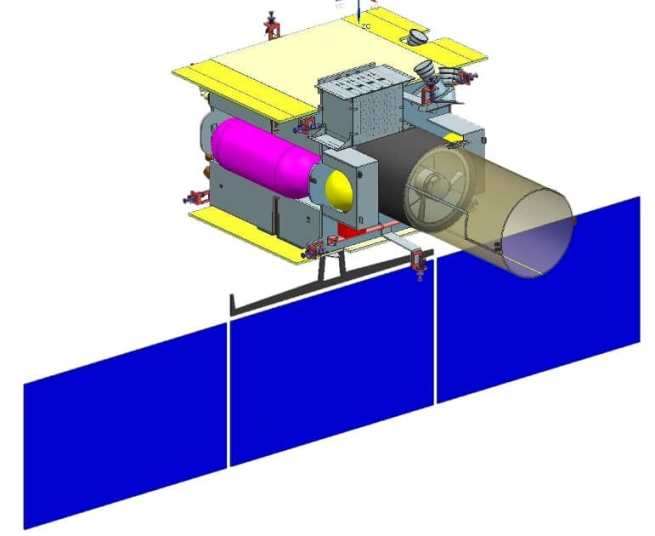GISAT-1/GSLV-F10
GSLV (Geosynchronous Satellite Launch Vehicle) is the largest launch vehicle developed by India.
GSLV Specifications
| Height | 49.13 m |
| Number of Stages | 3 |
| Lift Off Mass | 414.75 tonnes |
| First Flight | April 18, 2001 |
Table of Contents
GSLV-F10/GISAT-1 Mission
GSLV-F10 will launch GISAT-1 (Geo Imaging Satellite-1) satellite from the Satish Dhawan Space Centre (SDSC) SHAR, Sriharikota, the date of Aug 12, 2021.
GISAT-1 is the latest earth observation Satellite developed by ISRO, that will be plased in a Geostationary orbit.
It will be continuously observe land, ocean and atmospheric parameters at relatively higher resolution ranging from 50-320 meters using appropriate spectral bands from different applications.
After reaching Geosynchronous transfer orbit it will be commanded from ground to reach it’s geostationary orbital slot by using own propulsion system. It is navegate over the indian subcontinent at 85.5 degrees east longitude. It will generate two-dimensional imagery by showing in to as east direction and stepping in north-south direction. The scan mode includes coverage of entire indian subcontinent landmass and oceans.
The mission life of satellite will be around 7 years. Imagery from GISAT-1 will be utilized for a host of applications, including;
- Crop monitoring at regional and national level
- Drought progression and assessment.
- Ocean and Coastal zone management
- Fog detection and warning
- Disaster management, dust monitoring, and many more.
Indial earth earth observation Satellite are the excellent example of the countri’s technological strength, enhancing the space technology for the development of the country.

GSLV-F10 Specifications
| Orbital slot | 85.50 E |
| Apogee | 36,297 km |
| Perigee | 170 km |
| Inclination | 19.4 deg |
| Lift-off mass | 2268 kg |
| Power generation | 2280 W |
Sensors and Resolution
| Sensors (Spectral band) | Resolution |
|---|---|
| Multi-Spectral Visible & Near-InfraRed (6 bands) | 42 m |
| Hyper-Spectral Visible & Near-InfraRed (158 bands) | 318 m |
| Hyper-Spectral Short Wave-InfraRed (256 bands) | 191 m |
Objectives
- Provide to near real time imaging of large area region of interest at frequent intervals.
- For quick monitoring of natural disasters, episodic events and any short term events.
- To obtain spectral signatures for agriculture, forestry, mineralogy, disaster warning, cloud.
List of GSLV Satellites
| Sl. No. | Title | Launch Date | Launcher Type | Orbit | Payload | Remarks |
|---|---|---|---|---|---|---|
| 15 | GSLV-F12/NVS-01 Mission | May 29, 2023 | GSLV | GTO (Geosynchronous Transfer Orbit) | NVS-01 | |
| 14 | GSLV-F10 / EOS-03 | Aug 12, 2021 | GSLV | GTO (Geosynchronous Transfer Orbit) | EOS-03 | Mission unsuccessful |
| 13 | GSLV-F11 / GSAT-7A Mission | Dec 19, 2018 | GSLV | GSAT-7A | ||
| 12 | GSLV-F08/GSAT-6A Mission | Mar 29, 2018 | GSLV | GSO (Geosynchronous Orbit) | GSAT-6A | |
| 11 | GSLV-F09 / GSAT-9 | May 05, 2017 | GSLV | GSO (Geosynchronous Orbit) | GSAT-9 | |
| 10 | GSLV-F05 / INSAT-3DR | Sep 08, 2016 | GSLV-MK-II | GTO (Geosynchronous Transfer Orbit) | INSAT-3DR | |
| 9 | GSLV-D6 | Aug 27, 2015 | GSLV-MK-II | GTO (Geosynchronous Transfer Orbit) | GSAT-6 | |
| 8 | GSLV-D5/GSAT-14 | Jan 05, 2014 | GSLV-MK-II | GTO (Geosynchronous Transfer Orbit) | GSAT-14 | |
| 7 | GSLV-F06 / GSAT-5P | Dec 25, 2010 | GSLV-MK-II | GTO (Geosynchronous Transfer Orbit) | GSAT-5P | Mission Unsuccessful |
| 6 | GSLV-D3 / GSAT-4 | Apr 15, 2010 | GSLV-MK-II | GSAT-4 | Mission Unsuccessful | |
| 5 | GSLV-F04 / INSAT-4CR | Sep 02, 2007 | GSLV-MK-II | GTO (Geosynchronous Transfer Orbit) | INSAT-4CR | |
| 4 | GSLV-F02 / INSAT-4C | Jul 10, 2006 | GSLV-MK-II | GTO (Geosynchronous Transfer Orbit) | INSAT-4C | Mission Unsuccessful |
| 3 | GSLV-F01 / EDUSAT(GSAT-3) | Sep 20, 2004 | GSLV-MK-II | GTO (Geosynchronous Transfer Orbit) | EDUSAT | |
| 2 | GSLV-D2 / GSAT-2 | May 08, 2003 | GSLV-MK-II | GTO (Geosynchronous Transfer Orbit) | GSAT-2 | |
| 1 | GSLV-D1 / GSAT-1 | Apr 18, 2001 | GSLV-MK-II | GTO (Geosynchronous Transfer Orbit) | GSAT-1 |
